Khajuraho – Madhya Pradesh
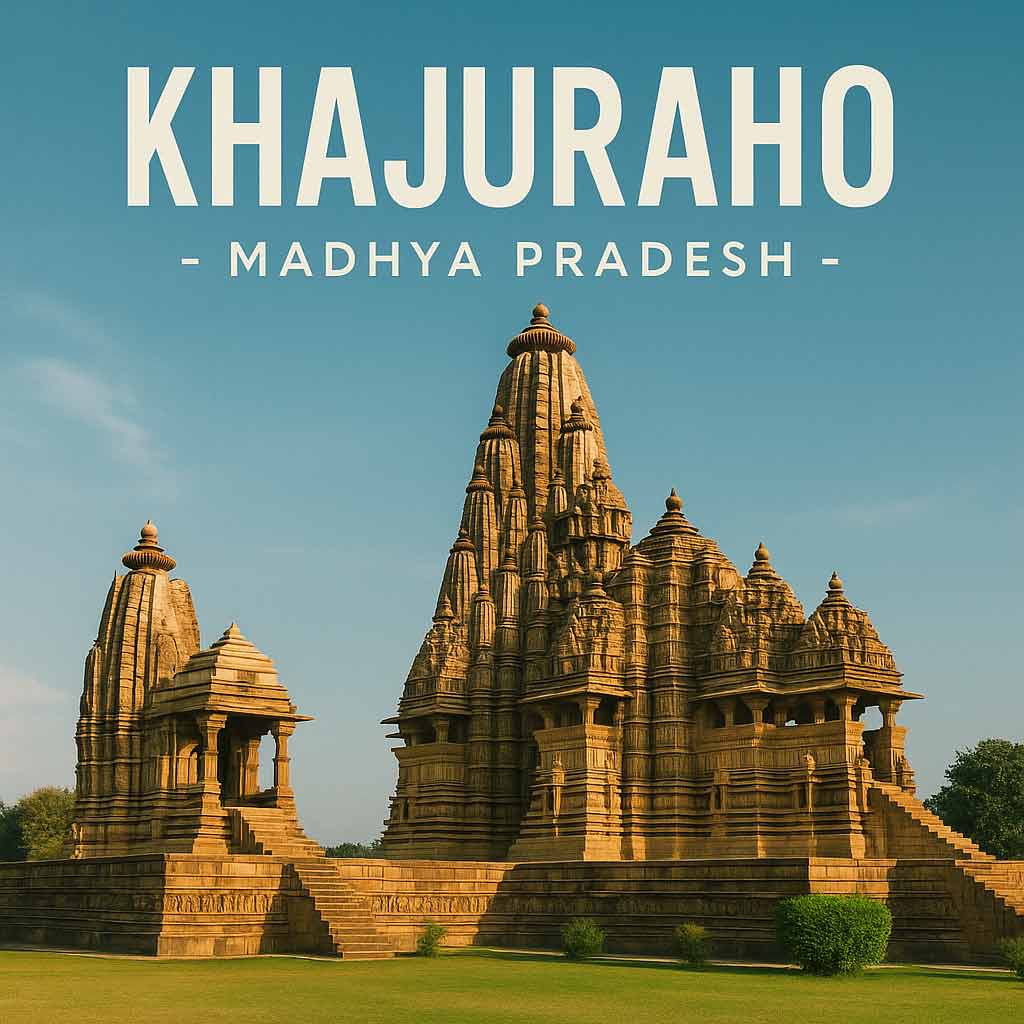
Khajuraho – Madhya Pradesh – The Timeless Temple City of Madhya Pradesh India’s fantasy land. A haven for the foreigners too. With long silvery beaches and swaying palms. The local people are very friendly and warm, welcoming tourists amidst their festivals and carnivals. Goa is simply divine in season with water games and Shacks selling mouth watering delicacies. During Christmas and New year everyone is out on the streets singing and dancing. The majority of the population are of Latin-Roman origin. Goa being a coastal area, Coconuts and Cashew nuts are abundant.It is from these Cashew fruits that the famous liquor Fenny is extracted. Khajuraho – The Timeless Temple City of Madhya Pradesh Located in the heart of India, Khajuraho is a breathtaking testament to the artistic and architectural brilliance of ancient India. Situated in the Chhatarpur district of Madhya Pradesh, Khajuraho is globally renowned for its magnificent group of temples adorned with intricate carvings that depict every aspect of human life. Designated as a UNESCO World Heritage Site, Khajuraho stands as a living example of India’s cultural richness, spirituality, and refined artistry that flourished over a thousand years ago. A Journey Through History The Khajuraho temples were built between the 9th and 12th centuries by the Chandela dynasty, one of the most powerful Rajput clans of Central India. Historical records suggest that there were originally 85 temples, of which about 25 have survived the passage of time. These temples were built over a span of nearly 200 years, representing a golden era of creativity and devotion. After the decline of the Chandelas, Khajuraho was largely forgotten and covered by dense forests for centuries. It was rediscovered in the 19th century by British engineer T.S. Burt in 1838, who was astonished by the grandeur and detail of the sculptures. Today, these temples are preserved and celebrated as one of India’s most treasured heritage sites. The Art and Architecture The temples of Khajuraho are renowned for their Nagara-style architecture, characterized by soaring shikharas (spires), elevated platforms, and detailed carvings that adorn every inch of their surfaces. Built primarily of sandstone, each temple sits on a high base platform, symbolizing the elevation from the earthly world to the divine. The sculptures of Khajuraho are what make it truly exceptional. They depict an astonishing range of themes — from gods and goddesses, celestial beings, musicians, and dancers to warriors and mythical creatures. Perhaps the most talked-about aspect of Khajuraho is its erotic sculptures, which represent just a small fraction (around 10%) of the carvings. Contrary to popular perception, these are not meant to be merely sensual but symbolize the celebration of life, love, and spiritual awakening. In Indian philosophy, human love is viewed as a path to divine union, and these depictions reflect that profound connection between the physical and spiritual realms. The temples, in essence, celebrate the completeness of existence — where earthly desires, devotion, and enlightenment coexist in harmony. The Main Temple Groups The Khajuraho temples are divided into three main groups: the Western, Eastern, and Southern groups, each representing different deities and architectural styles. Western Group: This is the largest and most celebrated cluster, home to the Kandariya Mahadeva Temple, dedicated to Lord Shiva. It is the grandest of all, with more than 800 sculptures depicting gods, celestial beings, and human figures in fluid, lifelike poses. Other notable temples here include the Lakshmana Temple and the Devi Jagadambi Temple, all celebrated for their intricacy and grace. Eastern Group: These temples are mainly Jain temples, including the Parshvanatha Temple and Adinatha Temple, which display exquisite carvings with less emphasis on sensuality and more on spiritual symbolism. Southern Group: This smaller group includes the Duladeo Temple and Chaturbhuja Temple, showcasing later developments in temple design and artistry. Together, these temples form a microcosm of Indian spirituality, celebrating both divine and human experiences. Culture and Experience Khajuraho is not only a site of ancient marvels but also a vibrant center of art and culture. The Khajuraho Dance Festival, held every February, brings together classical dancers from across India who perform traditional dance forms like Bharatanatyam, Kathak, Odissi, and Kuchipudi against the stunning backdrop of the illuminated temples. The event is a celebration of India’s performing arts heritage and adds a magical dimension to the site. Visitors can also explore the Archaeological Museum, which houses sculptures and artifacts excavated from the area, offering deeper insights into Chandela art and society. Beyond the temples, Khajuraho’s serene rural surroundings, with its lakes and greenery, provide a peaceful retreat for travelers seeking both spiritual and aesthetic experiences. Symbolism and Legacy Khajuraho’s temples stand as a profound expression of the Hindu philosophy of life — encompassing dharma (duty), artha (prosperity), kama (desire), and moksha (liberation). The carvings are not just ornamental but narrative, representing the eternal cycle of creation and the harmony between body, mind, and spirit. The legacy of Khajuraho endures as a reminder that art and spirituality can coexist in perfect balance. It tells the world that ancient India was not merely a land of rituals and religion but also of imagination, sensuality, and intellectual depth. Conclusion Khajuraho is far more than a collection of temples — it is a poetic reflection of human existence in stone. Every sculpture, every spire, and every carving speaks of a civilization that saw divinity in every aspect of life. For travelers, historians, and seekers alike, Khajuraho remains an unforgettable journey into the soul of India — a place where time stands still, and beauty speaks the language of eternity.
Tirupati – Andhra Pradesh

Tirupati – Andhra Pradesh – The Spiritual Crown of Andhra Pradesh Tirupati – The Spiritual Crown of Andhra Pradesh Tirupati, nestled at the foothills of the sacred Tirumala Hills in the Chittoor district of Andhra Pradesh, is one of India’s most revered pilgrimage destinations. Renowned worldwide for the Sri Venkateswara Temple (popularly known as the Tirupati Balaji Temple), this holy city attracts millions of devotees each year, making it one of the most visited religious sites on Earth. Beyond its spiritual magnetism, Tirupati also embodies South India’s cultural richness, natural beauty, and architectural grandeur. The Abode of Lord Venkateswara At the heart of Tirupati’s spiritual allure lies the Tirumala Venkateswara Temple, perched atop the Seshachalam Hills, about 20 kilometers from the main city. Dedicated to Lord Venkateswara, an incarnation of Lord Vishnu, the temple is believed to be over a thousand years old. According to Hindu mythology, Lord Vishnu descended here to save mankind from the trials of the Kali Yuga. The temple’s sanctum, adorned with a golden dome (Ananda Nilayam), houses the idol of Lord Venkateswara, which exudes divine grace and serenity. Every day, thousands of devotees, often after long pilgrimages or vows, stand in queues for hours just to catch a glimpse — or darshan — of the deity. The devotion is palpable, and the experience often leaves visitors deeply moved. The temple is also famous for its offerings, particularly the Tirupati Laddu, a sweet prasadam that has received a Geographical Indication (GI) tag for its unique preparation and taste. The temple administration, Tirumala Tirupati Devasthanams (TTD), manages the rituals, festivals, and massive logistics that make this pilgrimage a model of organization and devotion. Mythology and Significance The legend of Tirupati is deeply intertwined with faith and love. It is believed that Lord Vishnu took the form of Venkateswara and came to Earth to marry Goddess Padmavati. The celestial wedding is re-enacted annually in a grand celebration known as the Brahmotsavam, one of the most important festivals in Tirupati. The event attracts lakhs of devotees who come to witness the vibrant rituals, music, and processions that light up the entire region. Another mythological belief holds that the seven peaks of the Tirumala Hills represent the seven heads of Adisesha, the serpent on whom Lord Vishnu rests, symbolizing eternal protection and divine presence. The Journey to the Divine The pilgrimage to Tirumala is as spiritual as the destination itself. Devotees can reach the temple either by road or by walking up the Alipiri Footpath, a traditional route with 3,550 steps spread over 11 kilometers. Pilgrims often carry coconuts or offerings and chant hymns as they ascend, creating an atmosphere filled with faith and energy. Another path, Srivari Mettu, is shorter and equally scenic, winding through forested hills. At the top, the cool breeze, serene temples, and panoramic views of the Eastern Ghats provide a deeply peaceful experience, rewarding both body and soul. Other Attractions in and Around Tirupati While Tirumala is the main attraction, Tirupati city itself boasts several significant sites: Padmavathi Ammavari Temple at Tiruchanur, dedicated to Goddess Padmavathi, the consort of Lord Venkateswara. Kapila Theertham, a sacred temple dedicated to Lord Shiva, located at the base of the hills with a natural waterfall nearby. Sri Govindarajaswami Temple, built in the 12th century, is another major Vaishnavite shrine with intricate architecture. Sri Venkateswara Zoological Park, one of the largest in Asia, offering a glimpse of the region’s flora and fauna. Silathoranam, a natural rock arch on the Tirumala hills, believed to be 2.5 million years old and symbolically linked to Lord Vishnu’s presence. For nature lovers, the region offers scenic waterfalls like Akasaganga and Papavinasam, known for their purity and spiritual significance. The City of Devotion and Service What makes Tirupati truly remarkable is the spirit of devotion that permeates every corner. The entire town revolves around service — from volunteers assisting pilgrims to the TTD’s free meal program that feeds thousands daily. The temple’s vast donations, contributed by devotees worldwide, are used to fund hospitals, schools, and social welfare programs, making Tirupati not just a spiritual center but also a force for community development. Conclusion Tirupati stands as a symbol of unwavering faith, discipline, and tradition. It is a place where millions find peace, hope, and divine connection amidst life’s chaos. Whether one comes as a pilgrim seeking blessings, an admirer of architecture, or a traveler in search of tranquility, Tirupati offers an experience that transcends the physical and touches the spiritual. In the gentle bells ringing through the hills, the chants echoing in the temple corridors, and the smiles of the countless devotees — Tirupati truly represents the spiritual heartbeat of Andhra Pradesh and the devotion of India itself.
Kanyakumari – Tamil Nadu
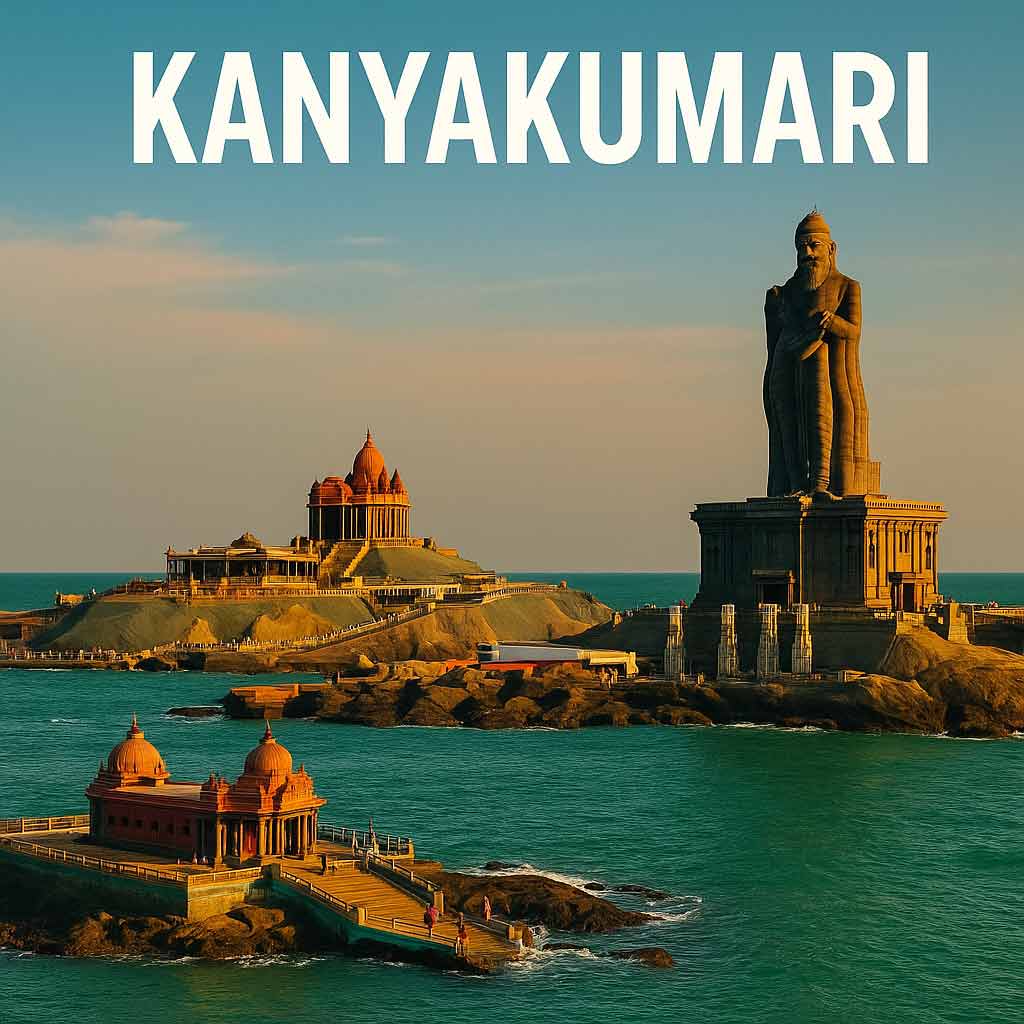
Kanyakumari – Tamil Nadu – Where the Oceans Meet and Cultures Converge Kanyakumari – Where the Oceans Meet and Cultures Converge At the southernmost tip of the Indian peninsula lies Kanyakumari, a breathtaking destination where nature’s grandeur, spirituality, and history merge in perfect harmony. Often called the “Land’s End of India,” Kanyakumari is the meeting point of three vast water bodies — the Indian Ocean, the Arabian Sea, and the Bay of Bengal. Located in the state of Tamil Nadu, this coastal town is a place of deep significance — geographically, culturally, and spiritually — offering travelers an experience that is both serene and inspiring. A Land of Natural Beauty and Sacred Waters Kanyakumari’s geography is one of its most defining features. Standing on its rocky shores, one can witness the mesmerizing sight of the sun rising and setting over the ocean — a rare spectacle visible from very few places in the world. The Triveni Sangam, where the three seas converge, holds special spiritual significance. The differing shades of the waters can often be seen merging, symbolizing unity amidst diversity. The Kanyakumari Beach is lined with colorful seashells, swaying palm trees, and the rhythmic sound of waves crashing against the rocks. The View Tower near the shore provides a panoramic glimpse of the confluence, the famous monuments, and the expansive horizon where sky and sea meet endlessly. The Legend of Kanya Devi The town derives its name from Devi Kanya Kumari, the virgin goddess who is an incarnation of Goddess Parvati. According to Hindu mythology, she was destined to marry Lord Shiva, but the wedding never took place. She remains eternally celibate, symbolizing purity and devotion. The Kumari Amman Temple, perched near the seashore, is dedicated to her. Pilgrims from across India visit to seek her blessings. The temple’s ancient Dravidian architecture and the powerful spiritual aura of the deity make it a focal point of the town’s identity. Vivekananda Rock Memorial – A Symbol of Enlightenment A short ferry ride from the mainland takes visitors to the Vivekananda Rock Memorial, built on a rocky island surrounded by the sea. It was constructed in 1970 to honor Swami Vivekananda, one of India’s greatest spiritual leaders, who meditated here in 1892 before embarking on his mission to spread the message of Vedanta worldwide. The memorial’s architecture blends traditional and modern Indian styles, with two main halls — one dedicated to Vivekananda and the other to the goddess Bhagavathi. Standing on the rock, surrounded by the vast ocean, visitors often experience a sense of peace and introspection. The spot also offers a stunning view of the sunrise and sunset — a scene that stays etched in memory. Thiruvalluvar Statue – Tribute to Tamil Wisdom Adjacent to the memorial stands the imposing Thiruvalluvar Statue, a 133-foot-tall stone sculpture honoring the legendary Tamil poet and philosopher Thiruvalluvar, the author of the Thirukkural. The height symbolizes the 133 chapters of his timeless work on ethics, governance, and love. The statue, visible from afar, is not just an architectural marvel but also a symbol of Tamil pride and intellectual legacy. Together, the statue and the rock memorial embody the spirit of India’s philosophy — blending spirituality, knowledge, and art. Cultural and Historical Significance Kanyakumari has been a center of culture and trade since ancient times. It was part of the Chera, Pandya, and Chola dynasties and later came under the rule of the Travancore Kingdom before joining Tamil Nadu. The city’s culture is a fusion of Tamil and Kerala traditions, visible in its cuisine, festivals, and attire. Apart from temples, Kanyakumari also houses the Gandhi Memorial, where a portion of Mahatma Gandhi’s ashes was kept before being immersed in the sea. The memorial’s architecture allows sunlight to fall exactly on the spot where the urn was placed every year on Gandhi’s birthday, October 2nd — a marvel of design and symbolism. Nature and Surroundings Beyond its monuments, Kanyakumari’s charm extends to its scenic surroundings. The nearby Suchindram Temple, Padmanabhapuram Palace, and Vattakottai Fort are worth exploring. The area is rich in biodiversity, with coconut groves, rice fields, and hills forming a beautiful backdrop. During monsoons, the entire landscape transforms into a lush green haven. Kanyakumari is more than just the southern tip of India — it is where the soul of the subcontinent converges. It represents the unity of oceans, faiths, and philosophies. The town’s spiritual calm, natural splendor, and cultural depth make it a destination that touches both the heart and the mind. Whether you seek reflection at the Vivekananda Rock, devotion at the Kumari Amman Temple, or the simple joy of watching the sun dip into the ocean, Kanyakumari offers an experience that is timeless, sacred, and unforgettable.
Amritsar – Punjab

Amritsar – Punjab – The Spiritual and Cultural Heart of Punjab Amritsar – The Spiritual and Cultural Heart of Punjab Amritsar, the crown jewel of Punjab, is a city that beautifully captures the essence of India’s spiritual depth, cultural richness, and historical resilience. Known worldwide for the magnificent Golden Temple, or Harmandir Sahib, Amritsar is not just a destination — it’s an experience of devotion, community, and pride. Founded in 1577 by Guru Ram Das, the fourth Sikh Guru, the city’s name derives from Amrit Sarovar — the “Pool of Nectar” that surrounds the Golden Temple. Over the centuries, Amritsar has evolved into a sacred pilgrimage center for Sikhs and a symbol of Punjabi heritage and hospitality. The Golden Temple – Heart of Sikhism The Golden Temple stands as Amritsar’s soul and a beacon of peace and equality. Its shimmering golden façade, reflected in the serene waters of the holy tank, creates a sight that touches every visitor’s heart. The temple’s architecture blends Islamic, Hindu, and Rajput influences, symbolizing unity and inclusiveness. At the heart of the temple is the Guru Granth Sahib, the Sikh holy scripture, revered by millions worldwide. The complex is open to all — regardless of religion, caste, or nationality — reflecting Sikhism’s foundational principles of equality and service. The Langar, or community kitchen, serves free meals daily to over 50,000 visitors, prepared and served by volunteers. This spirit of selfless service and brotherhood defines Amritsar’s ethos. Visiting the Golden Temple at dawn or under the moonlight is a transcendent experience. The soft devotional music, the aroma of fresh karah prasad, and the sound of prayers resonate with serenity and faith. A City of History and Resilience Amritsar has witnessed many pivotal moments in India’s history. One of the most tragic yet defining events occurred in 1919 — the Jallianwala Bagh Massacre, where British troops opened fire on unarmed civilians gathered for a peaceful protest. Today, Jallianwala Bagh stands as a national memorial, honoring those who sacrificed their lives in India’s freedom struggle. The preserved bullet marks and the eternal flame remind visitors of the city’s resilience and the cost of freedom. Another key attraction is the Partition Museum, located near the Town Hall, which offers an emotional journey through one of the largest human migrations in history — the partition of India in 1947. The exhibits tell personal stories of loss, hope, and survival, making it one of the most moving museums in the country. The Spirit of Patriotism – Wagah Border Just 30 kilometers from the city lies the Wagah Border, where India and Pakistan meet. Every evening, the Beating Retreat Ceremony transforms the border into a stage of national pride. Soldiers from both sides perform a synchronized display of drill and flag-lowering, accompanied by patriotic chants and enthusiastic crowds. The atmosphere is electric, showcasing India’s unity and spirit. Cuisine and Culture No visit to Amritsar is complete without indulging in its legendary cuisine. The city is a paradise for food lovers — from Amritsari kulcha stuffed with spicy potatoes and served with butter-laden chole, to lassi topped with a thick layer of cream. Street food stalls near the Golden Temple serve delicious langar prasad, jalebis, paneer tikkas, and sarson da saag with makki di roti, embodying Punjab’s warmth and abundance. Amritsar is also known for its bustling markets like Hall Bazaar and Katra Jaimal Singh, offering vibrant phulkari embroidery, juttis (traditional footwear), and souvenirs. Festivals like Baisakhi, celebrating the Sikh New Year and the harvest season, fill the city with music, color, and joy. Modern Amritsar – Blending Heritage and Growth While deeply rooted in tradition, Amritsar is also a modern, fast-growing city. The newly developed Heritage Street leading to the Golden Temple features restored facades that evoke old-world charm, while the Gobindgarh Fort has been converted into a multimedia cultural experience showcasing Punjab’s history. The city’s international airport and improved connectivity have made it a gateway to northwestern India. Amritsar is more than just a destination — it is a feeling that stays with every visitor. It radiates the essence of Punjab’s soul — devotion, courage, and hospitality. From the tranquil waters of the Golden Temple to the patriotic fervor of the Wagah Border and the flavors of its bustling streets, Amritsar offers an experience that touches both heart and spirit. It is, truly, the sacred and cultural heartbeat of India — a city where history, faith, and humanity converge.
Delhi – The Capital City
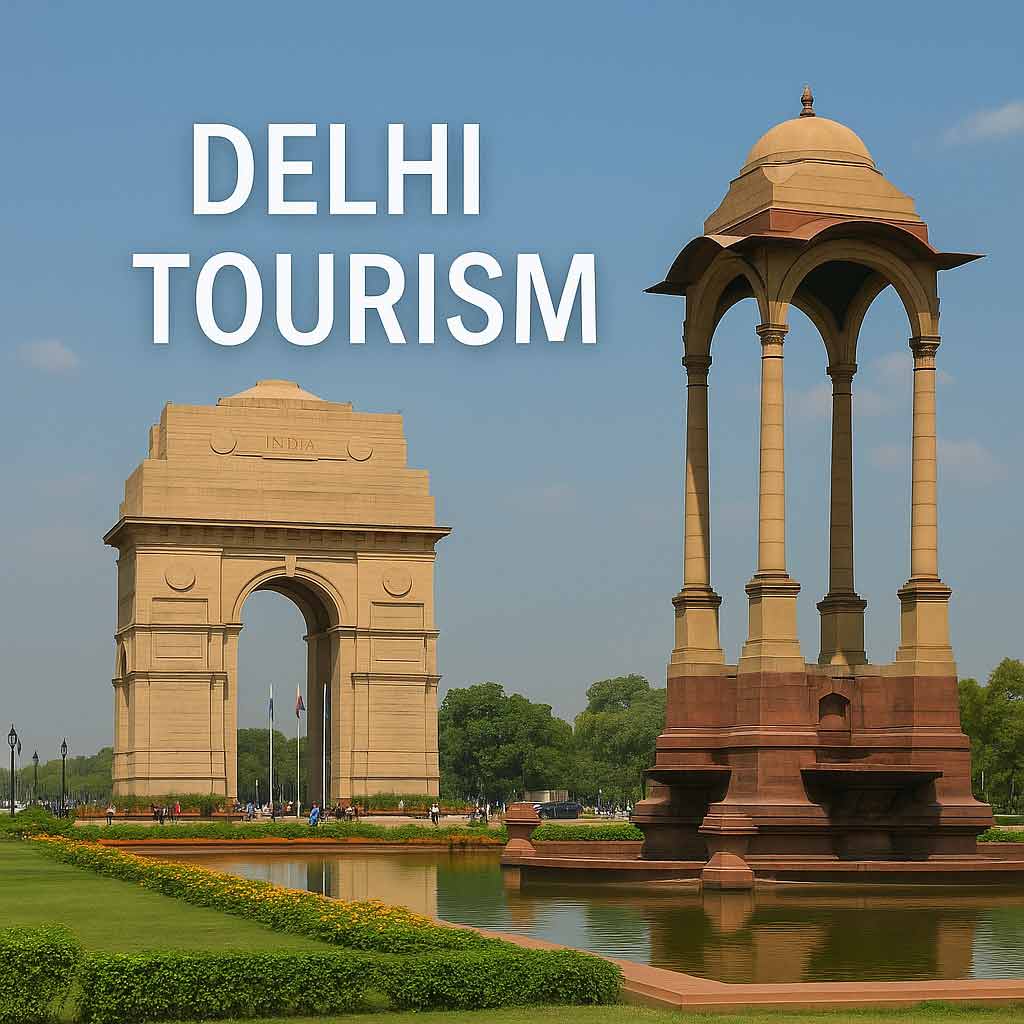
Delhi – The Capital City –Where Heritage Meets Modernity Delhi Tourism: Where Heritage Meets Modernity Delhi, the heart of India, is a city where time seamlessly weaves together the grandeur of the past with the vibrancy of the present. As the capital of India, Delhi is not just a seat of political power but also a cultural kaleidoscope — brimming with magnificent monuments, bustling markets, diverse cuisines, and modern infrastructure. For travelers, Delhi offers a journey through centuries — from the ruins of ancient empires to the glimmering skyline of a cosmopolitan metropolis. A City of Timeless Heritage Delhi’s history stretches back over 2,000 years, having been the capital of several dynasties — from the Tomars and Mughals to the British. This rich past is reflected in its architecture, monuments, and layout. The Red Fort (Lal Qila), built by Mughal Emperor Shah Jahan, stands as a symbol of India’s sovereignty and grandeur. Nearby, the Jama Masjid, one of India’s largest mosques, invites awe with its imposing domes and marble courtyards. The Qutub Minar, a UNESCO World Heritage Site, rises gracefully above the southern skyline, surrounded by ancient ruins and inscriptions. Equally captivating is Humayun’s Tomb, a stunning precursor to the Taj Mahal, exemplifying Mughal artistry at its best. The Purana Qila (Old Fort), believed to be built on the site of ancient Indraprastha mentioned in the Mahabharata, adds another layer of historical depth. No visit to Delhi is complete without witnessing the India Gate, an iconic war memorial, and the surrounding Rajpath, which comes alive during the Republic Day Parade every January 26th. Nearby, the stately Rashtrapati Bhavan, home to the President of India, showcases colonial architecture at its grandest. Spiritual and Cultural Diversity Delhi’s soul lies in its diversity. From the echoing azaan of mosques to the melodic bells of temples, the city embodies India’s secular spirit. The Lotus Temple, with its serene, flower-shaped architecture, welcomes people of all faiths. The Akshardham Temple, with intricate carvings and evening water shows, is a masterpiece of modern craftsmanship. The Gurudwara Bangla Sahib, located in the heart of New Delhi, offers spiritual solace and community meals (langar) to thousands daily. The Chandni Chowk area in Old Delhi remains a sensory explosion — narrow lanes teeming with life, ancient havelis, and legendary food stalls serving parathas, kebabs, jalebis, and chaats. This old-world charm coexists with the sleek malls and fine dining restaurants of Connaught Place, Hauz Khas Village, and Saket, representing the city’s evolving face. Museums, Art, and Modern Attractions Delhi is a cultural hub with numerous museums, art galleries, and theaters. The National Museum, Nehru Memorial Museum, and Gandhi Smriti offer deep insights into India’s heritage and freedom struggle. The Crafts Museum and Dilli Haat showcase India’s vibrant handicrafts and folk traditions. For contemporary art lovers, the National Gallery of Modern Art and smaller private galleries in Lodhi Art District and Okhla present impressive collections of Indian creativity. Modern Delhi dazzles with the Metro network, sleek flyovers, and world-class infrastructure. The Kingdom of Dreams in nearby Gurgaon and events like the Delhi International Arts Festival make the city a cultural hotspot for both locals and tourists. Parks and Green Spaces Despite its urban chaos, Delhi is one of the greenest capitals in the world. The Lodhi Gardens, dotted with Mughal tombs, are perfect for a morning walk. The Garden of Five Senses, Deer Park, and the vast Ridge Forest offer tranquil escapes within the city. A Gateway to India Delhi also serves as the gateway to northern India. From here, travelers can easily visit Agra, Jaipur, Haridwar, or Rishikesh, making it the starting point for the famous Golden Triangle Tour. Delhi is not merely a city — it is an experience. Every street whispers stories of emperors, saints, poets, and revolutionaries. It balances the ancient and the modern, the spiritual and the political, the chaotic and the calm. Whether you come to explore its history, savor its cuisine, or soak in its vibrant culture, Delhi leaves an indelible impression on every traveler’s heart — a city truly deserving of the title, “Dilli Dilwalon Ki” — the city of big-hearted people.
Andaman & Nicobar Islands

Andaman & Nicobar Islands – he Emerald Jewels of the Bay of Bengal Andaman & Nicobar Islands: The Emerald Jewels of the Bay of Bengal Nestled in the southeastern reaches of the Bay of Bengal, the Andaman and Nicobar Islands form one of India’s most captivating tropical destinations. Comprising over 500 islands, islets, and rocks, this archipelago is a paradise of pristine beaches, turquoise waters, lush forests, and rich cultural heritage. Only about 30 of these islands are inhabited, and each has its unique charm, offering visitors a perfect blend of natural beauty, adventure, and tranquility. A Glimpse into History and Geography The islands stretch over 800 kilometers from north to south and are divided into two groups — the Andaman Islands to the north and the Nicobar Islands to the south. The capital city, Port Blair, located in South Andaman, serves as the entry point and administrative center. The history of the Andaman and Nicobar Islands is fascinating. Archaeological evidence suggests that indigenous tribes have inhabited these islands for more than 30,000 years. Tribes like the Great Andamanese, Onge, Jarawa, and Sentinelese are among the oldest surviving human groups, maintaining their traditional lifestyles even today. During the British colonial period, the islands gained notoriety as a penal settlement, with the Cellular Jail in Port Blair symbolizing the sufferings of Indian freedom fighters. Today, the jail stands as a national memorial, attracting visitors from across the country. Natural Beauty and Biodiversity The Andaman and Nicobar Islands are blessed with breathtaking natural beauty. The crystal-clear waters, coral reefs, and marine biodiversity make it a haven for divers and nature lovers alike. Radhanagar Beach on Havelock Island (now Swaraj Dweep) is consistently ranked among Asia’s best beaches for its powdery white sands and stunning sunsets. Elephant Beach, Vijaynagar Beach, and Kalapathar Beach are equally mesmerizing. The islands are rich in biodiversity, both terrestrial and marine. The dense tropical rainforests are home to unique flora and fauna, including saltwater crocodiles, giant sea turtles, and exotic bird species like the Nicobar pigeon. The Mahatma Gandhi Marine National Park, located near Wandoor, offers a spectacular glimpse of coral reefs and colorful marine life. The Nicobar group of islands, though less accessible to tourists due to ecological sensitivities and tribal reserves, possesses equally unspoiled beauty. Great Nicobar Island, the largest in the chain, houses the Indira Point, India’s southernmost tip. Adventure and Activities For adventure enthusiasts, the Andaman Islands are a dream destination. Scuba diving, snorkeling, sea walking, kayaking, and glass-bottom boating reveal the vibrant underwater world teeming with coral gardens and tropical fish. Havelock Island and Neil Island (Shaheed Dweep) are popular for diving, while North Bay Island near Port Blair offers easier access for beginners. Trekking through forest trails, exploring limestone caves at Baratang, and watching mud volcanoes add to the sense of adventure. The Mount Harriet National Park provides scenic viewpoints overlooking lush greenery and the sea. Culture and People The islands are home to a mix of communities — from indigenous tribes to settlers from mainland India, Myanmar, and Sri Lanka. This cultural mosaic is reflected in the local cuisine, festivals, and handicrafts. Seafood is a staple, with delicious curries and coastal flavors dominating the cuisine. Though English and Hindi are widely spoken, Bengali, Tamil, Telugu, and Nicobarese languages are also prevalent. The local lifestyle is relaxed, with strong ties to nature and the sea. Sustainability and Conservation In recent years, sustainable tourism has become a key focus. Efforts are being made to preserve the fragile marine ecosystems and tribal cultures. Plastic bans, eco-friendly accommodations, and awareness campaigns have been introduced to ensure that tourism growth does not compromise the islands’ ecological integrity. The Andaman and Nicobar Islands are not just a tropical getaway but a living showcase of India’s natural and cultural diversity. With their shimmering beaches, historical landmarks, and vibrant underwater life, they offer an escape into serenity and wonder. Whether you seek adventure, reflection, or relaxation, these emerald islands promise an unforgettable experience — a timeless dance of sun, sea, and soul in the heart of the Bay of Bengal.
Ladakh – Jammu & Kashmir
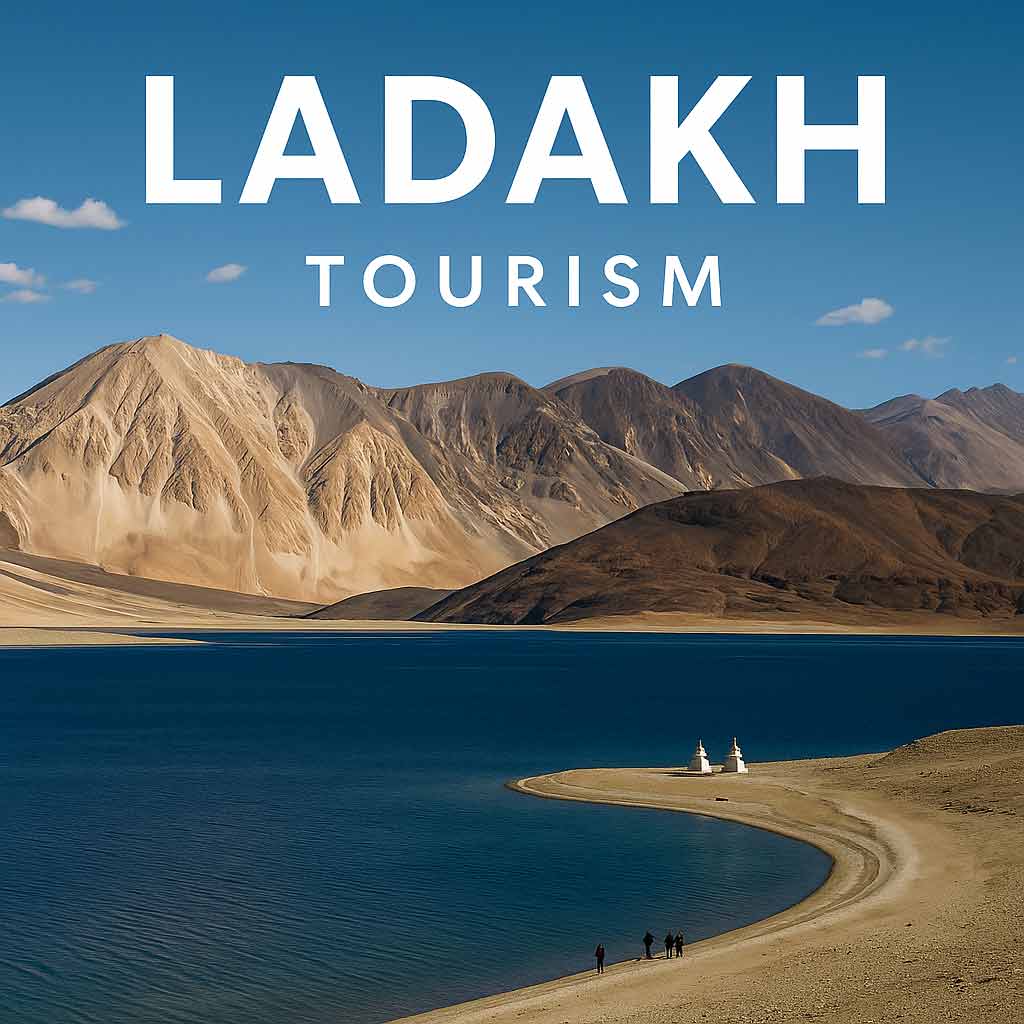
Ladakh – Jammu & Kashmir – The Land of High Passes Ladakh Tourism – The Land of High Passes Perched high in the Himalayas, Ladakh, often called the “Land of High Passes,” is one of India’s most spectacular and surreal destinations. Nestled between the Karakoram and Himalayan mountain ranges, this union territory offers a landscape so dramatic that it seems otherworldly — barren mountains streaked with color, crystal-clear lakes, ancient monasteries, and vast skies that stretch endlessly above. Located at an altitude ranging from 9,000 to 25,000 feet, Ladakh is not just a place; it’s an experience that touches your soul. With its pristine beauty, unique Buddhist culture, and thrilling adventures, it stands as a crown jewel of India’s northern frontier. A Landscape Beyond Imagination Ladakh’s beauty is raw, vast, and breathtaking. The region’s high-altitude desert terrain, sculpted by wind and time, is dotted with emerald valleys, glacial streams, and rugged mountain passes. Every curve on its winding roads reveals a new panorama — from the golden mountains of Lamayuru, often called “Moonland,” to the turquoise expanse of Pangong Lake, whose waters change color with the shifting light. Equally captivating is Tso Moriri, a high-altitude lake surrounded by snow peaks, and Nubra Valley, a cold desert where sand dunes coexist with the gentle flow of the Shyok and Nubra rivers. The Khardung La Pass, one of the highest motorable roads in the world, offers breathtaking views that leave travelers awestruck. For those seeking solitude and spiritual calm, Ladakh’s serene beauty is meditative — a reminder of nature’s power and peace. Culture and Spirituality Ladakh is deeply rooted in Tibetan Buddhism, evident in its architecture, festivals, and daily life. The region is adorned with ancient monasteries (gompas) perched on cliffs, their whitewashed walls contrasting beautifully with the surrounding brown mountains. The Hemis Monastery, the largest and wealthiest in Ladakh, comes alive during the Hemis Festival, where masked dances, vibrant costumes, and rhythmic chants celebrate the triumph of good over evil. Other must-visit monasteries include Thiksey, Diskit, Alchi, and Spituk, each offering spiritual solace and a glimpse into centuries-old Buddhist traditions. Colorful prayer flags flutter in the mountain winds, symbolizing peace and compassion. The locals — warm, humble, and deeply connected to their land — live in harmony with nature, reflecting the Buddhist philosophy of simplicity and mindfulness. Adventure in the Himalayas For adventure enthusiasts, Ladakh is a playground like no other. Its rugged terrain and challenging altitudes attract trekkers, bikers, and thrill-seekers from across the globe. The Markha Valley Trek, Chadar Trek (on the frozen Zanskar River), and Stok Kangri climb are among the most famous expeditions in India. Motorcyclists dream of conquering the Manali-Leh Highway or the Srinagar-Leh route, both offering adrenaline-pumping drives through hairpin bends, roaring rivers, and snow-covered passes. For cyclists, the Khardung La challenge is an ultimate test of endurance. Adventure also takes quieter forms here — from rafting in the icy Zanskar River to camping under a canopy of a million stars, Ladakh offers thrills for every soul, whether daring or contemplative. A Region of Living Heritage Beyond its mountains and monasteries, Ladakh is a region of living culture. Traditional mud-brick houses, vibrant markets in Leh, and the rhythmic beats of Ladakhi music bring life to its high-altitude towns. The cuisine — from thukpa (noodle soup) and momos to butter tea — reflects a blend of Tibetan and Indian flavors, perfect for warming up in the cool mountain air. Festivals like Losar, Ladakh Festival, and Yuru Kabgyat fill the valleys with music, dance, and color, offering travelers a chance to connect deeply with Ladakh’s spirit of joy and community. Best Time to Visit and Travel Tips The best time to visit Ladakh is from May to September, when the roads are open, and the weather is pleasant. During these months, the region transforms into a paradise for photographers and adventurers alike. Winter, though harsh, reveals a quieter side of Ladakh — frozen rivers, snow-clad monasteries, and endless silence. Travelers are advised to acclimatize gradually to the high altitude, stay hydrated, and respect local customs and the fragile mountain environment. Conclusion Ladakh is more than just a destination — it’s a journey to the roof of the world, a place where nature, spirituality, and adventure blend seamlessly. From the shimmering blues of Pangong Lake to the chants echoing through ancient monasteries, every moment here is poetry in motion. In Ladakh, one doesn’t just witness beauty — one feels it, breathes it, and carries it forever. Truly, it’s a land where heaven meets earth — a timeless adventure for the heart and soul.
Mysuru – Karnataka
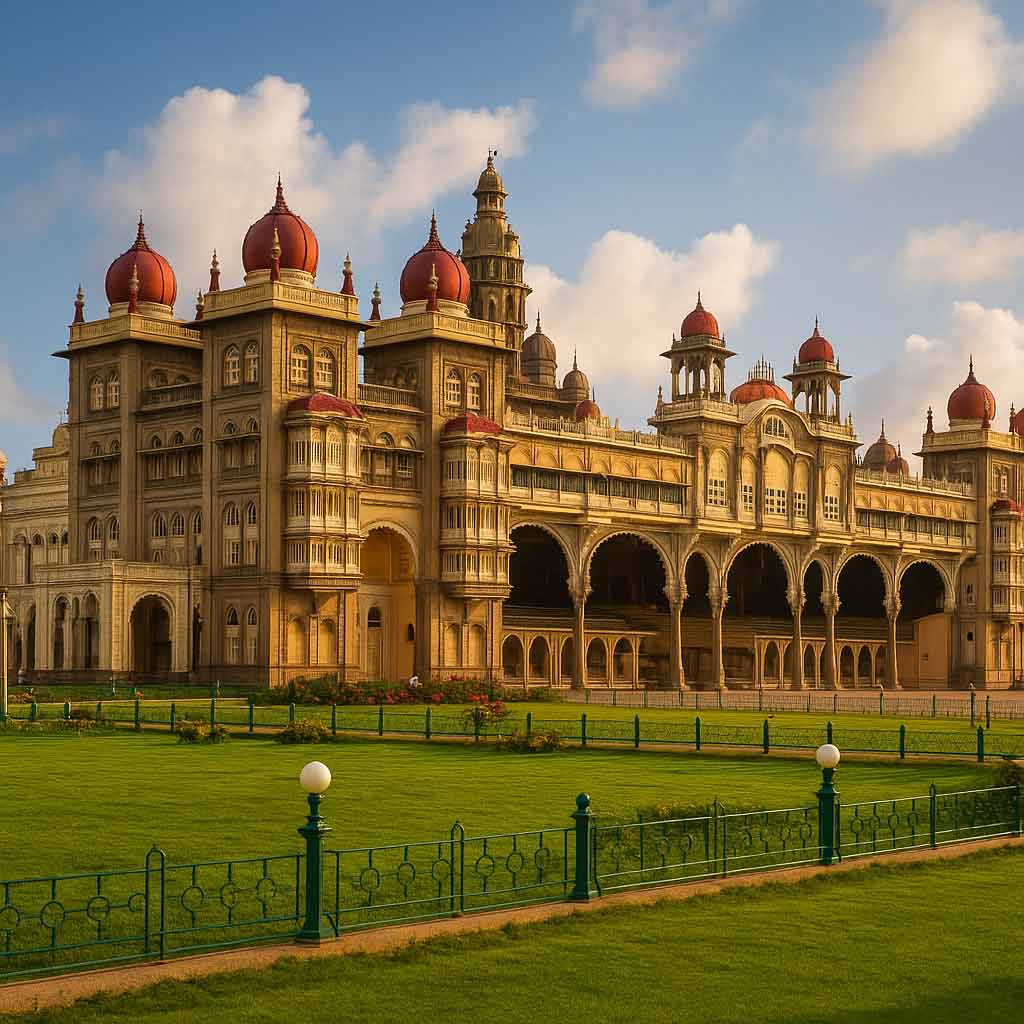
Mysuru – Karnataka – The Royal Heritage City of Karnataka Mysuru – The Royal Heritage City of Karnataka Located in the southern part of Karnataka, Mysuru (formerly Mysore) is one of India’s most enchanting cities — a place where royal heritage, traditional art, and natural beauty coexist in perfect harmony. Often referred to as the “Cultural Capital of Karnataka” and “City of Palaces,” Mysuru stands as a proud reminder of the grandeur of India’s royal past while embracing the energy of modernity. Nestled at the foot of the Chamundi Hills, Mysuru is a destination that captivates travelers with its magnificent palaces, vibrant festivals, sandalwood-scented streets, and timeless traditions. A Royal Legacy Mysuru’s glory dates back to the Wodeyar dynasty, which ruled the region for more than six centuries. The city’s identity is deeply intertwined with the grandeur of its royal lineage, and nowhere is this more evident than in the majestic Mysore Palace, also known as the Amba Vilas Palace. Built in the Indo-Saracenic architectural style, the palace is an opulent masterpiece adorned with domes, arches, intricate carvings, and stained-glass ceilings. When illuminated by nearly 100,000 lights every Sunday evening and during the Dasara Festival, it transforms into a breathtaking spectacle of light and splendor. The palace’s grandeur, coupled with the legacy of royal patronage, has earned Mysuru its place among India’s top tourist destinations. Dasara – The Festival of Royal Splendor The Mysuru Dasara Festival, celebrated during the Navaratri season (September–October), is one of India’s grandest cultural events. Dating back over 400 years, it symbolizes the triumph of good over evil and showcases the city’s rich heritage. The ten-day festival features elaborate processions, music, dance, traditional performances, and exhibitions. The highlight is the Jamboo Savari, a majestic parade in which a golden howdah carrying an idol of Goddess Chamundeshwari is placed atop a beautifully decorated elephant. Streets are illuminated, the palace glows, and the entire city pulsates with a festive spirit that draws visitors from across the globe. Temples and Spiritual Heritage Overlooking the city from a height of 1,000 meters, the Chamundeshwari Temple on Chamundi Hill is one of Mysuru’s most revered landmarks. Dedicated to Goddess Chamundeshwari, the presiding deity of Mysuru, the temple attracts thousands of pilgrims. The 1,008 stone steps leading up to the shrine offer a rewarding climb, and the panoramic view of the city from the hilltop is simply stunning. At the foothill lies the colossal Nandi Statue, carved out of a single granite block, symbolizing Mysuru’s devotion and artistic craftsmanship. Culture, Art, and Architecture Mysuru is not just a royal city — it’s a living museum of Karnataka’s culture and art. The Jaganmohan Palace, once the royal residence, now houses one of India’s finest art galleries, featuring works by Raja Ravi Varma and other celebrated painters. The city is also famous for its Mysore silk sarees, known for their fine quality and intricate gold zari work, and Mysore sandalwood, used to create perfumes, soaps, and incense that are cherished worldwide. The traditional Mysore painting style — detailed, graceful, and rooted in spirituality — continues to thrive here. Music and dance are integral to Mysuru’s cultural identity. The city has produced legendary Carnatic musicians and Bharatanatyam dancers, keeping its artistic soul alive through generations. Nature and Serenity Beyond its palaces and temples, Mysuru offers tranquil escapes. The Brindavan Gardens, located near the Krishna Raja Sagara (KRS) Dam, are famous for their symmetrical design and musical fountain show. The gardens come alive at dusk when lights reflect beautifully on the flowing water. Nature lovers can also visit the Mysore Zoo (Sri Chamarajendra Zoological Gardens), one of India’s oldest and most well-maintained zoos, home to rare species and lush landscapes. A Gateway to Southern Karnataka Mysuru serves as a convenient base for exploring nearby attractions such as Srirangapatna — the historical capital of Tipu Sultan, the Ranganathittu Bird Sanctuary, and the scenic Coorg (Kodagu) hills. With its excellent connectivity, Mysuru is just a few hours’ drive from Bengaluru, making it a favorite weekend getaway for travelers seeking heritage and peace. Mysuru is more than just a city — it is a living legacy of India’s royal grandeur and cultural depth. Its majestic palaces, sacred temples, aromatic markets, and warm people make it a destination that resonates with elegance and charm. Whether it’s witnessing the illuminated palace during Dasara, walking through sandalwood-scented bazaars, or admiring art from a bygone era, Mysuru offers an experience that lingers in the heart long after one leaves. Truly, it stands as a jewel in Karnataka’s crown — a city where the past lives gracefully in the present.
Kerala – God’s Own Country
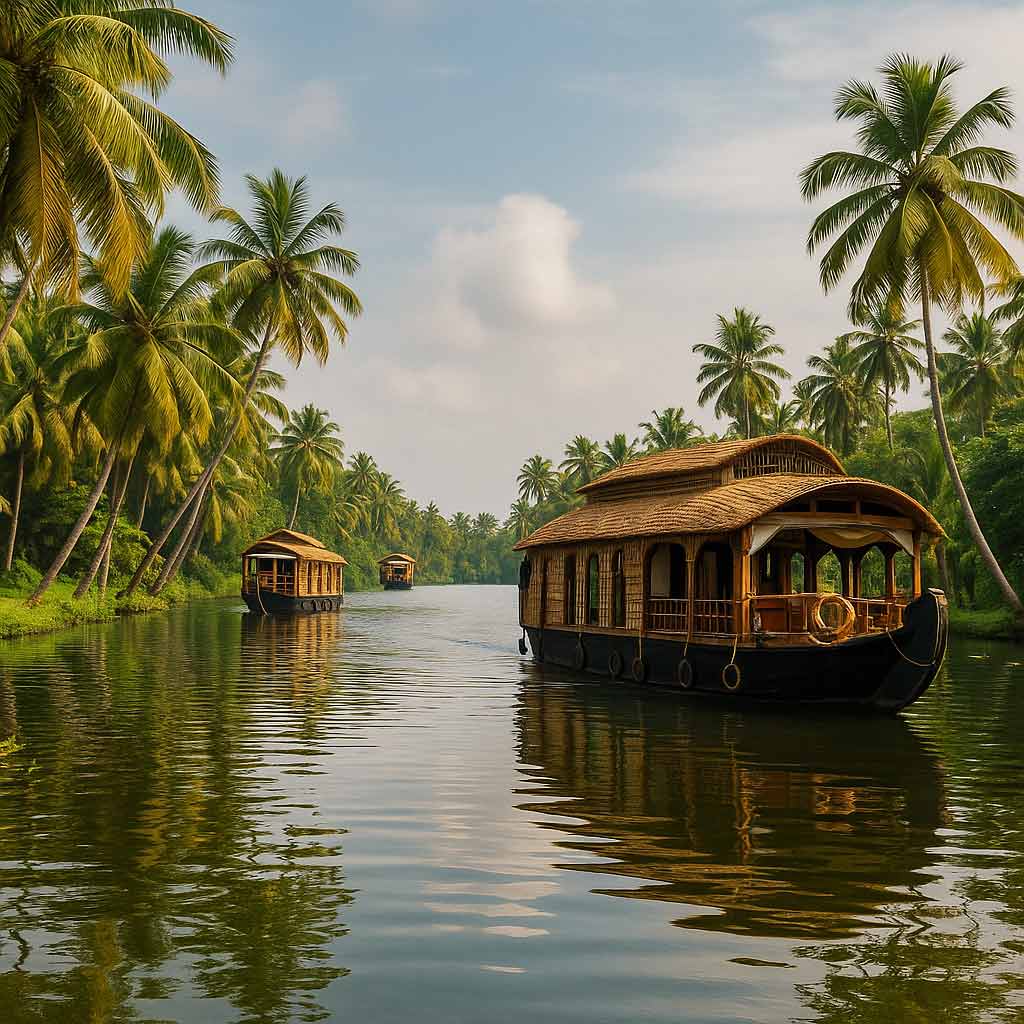
Kerala – God’s Own Country – God’s Own Country Kerala Tourism – God’s Own Country Tucked away in the southern tip of India, Kerala, often referred to as “God’s Own Country,” is a land blessed with breathtaking natural beauty, vibrant traditions, and serene spirituality. Bordered by the majestic Western Ghats on one side and the Arabian Sea on the other, Kerala offers a diverse landscape — from lush hill stations and tranquil backwaters to golden beaches and dense forests. Its harmonious blend of culture, nature, and wellness makes it one of India’s most sought-after travel destinations. Backwaters – The Soul of Kerala The backwaters of Kerala are the heart and soul of the state’s tourism. A network of tranquil lagoons, lakes, and canals, these waterways stretch across the coastal regions, offering an unforgettable experience of serenity. The most famous backwater destination is Alleppey (Alappuzha), known as the Venice of the East. Here, traditional houseboats or kettuvallams glide gently over the emerald waters, passing through swaying coconut palms, green paddy fields, and quaint villages. Cruising through these backwaters gives travelers a glimpse of Kerala’s rural life — fishermen casting their nets, women washing clothes on the riverbanks, and children waving from the shores. Nearby, Kumarakom and Ashtamudi also offer luxurious backwater resorts and bird sanctuaries, making them ideal for those seeking relaxation and natural beauty. Hill Stations and Wildlife Beyond the coastline, Kerala’s highlands are equally captivating. The misty hill station of Munnar, nestled in the Western Ghats, is a paradise of rolling tea plantations, spice gardens, and waterfalls. The aroma of cardamom and the cool mountain air make it an ideal retreat for honeymooners and nature lovers. Wayanad, another gem, is known for its lush forests, ancient caves, and wildlife sanctuaries. The Periyar Wildlife Sanctuary in Thekkady offers a chance to spot elephants, tigers, and exotic birds while enjoying a peaceful boat ride on the Periyar Lake. For adventure enthusiasts, Kerala’s mountains offer trekking, bamboo rafting, and plantation walks, while its forests provide an opportunity to reconnect with nature in its purest form. Beaches and Ayurveda Kerala’s coastal charm is unmatched. The sun-kissed beaches of Kovalam, Varkala, Marari, and Bekal offer golden sands, turquoise waters, and spectacular sunsets. Kovalam, with its crescent-shaped coastline, is famous for swimming, surfing, and traditional Ayurvedic spas by the sea. Varkala Beach, perched below a dramatic cliff, combines natural beauty with spirituality, as the Papanasam Beach is believed to wash away sins. Kerala is also the birthplace of Ayurveda, one of the world’s oldest systems of natural healing. Across the state, Ayurvedic resorts and wellness centers offer rejuvenating therapies, massages, and detox treatments. The holistic experience of Ayurveda, combined with yoga and meditation, makes Kerala a global destination for wellness tourism. Culture, Cuisine, and Festivals Kerala’s charm goes beyond its landscapes — it thrives in its culture and people. The state is known for its rich artistic traditions like Kathakali, Mohiniyattam, and Kalaripayattu (martial arts). Its temples, churches, and mosques reflect centuries of harmony and heritage. The Thrissur Pooram festival, with its grand elephant procession and fireworks, is a visual spectacle that embodies Kerala’s festive spirit. The cuisine of Kerala is a delightful fusion of flavors — coconut, curry leaves, and spices form the essence of its dishes. Whether it’s the lavish Sadya (vegetarian feast served on banana leaves), Karimeen Pollichathu (pearl spot fish), or Appam with Stew, Kerala’s culinary diversity leaves every visitor enchanted. Eco-Tourism and Responsible Travel Kerala has also emerged as a leader in eco-tourism and responsible travel. The state promotes community-based tourism through initiatives like Kumarakom’s Responsible Tourism Project, ensuring that local communities benefit from tourism while preserving the environment. The lush greenery, abundant wildlife, and sustainable practices make Kerala a model for conscious travel. From the tranquil backwaters of Alleppey to the misty hills of Munnar, from the golden beaches of Kovalam to the soulful chants along the Ganges of the South, Kerala is a mosaic of experiences. It’s a place where every sunrise brings peace, every sunset inspires awe, and every journey leaves a lasting imprint on the heart. Indeed, Kerala isn’t just a destination — it’s an emotion, a harmony of nature, culture, and humanity. Whether you seek relaxation, adventure, or spiritual awakening, Kerala — God’s Own Country — welcomes you with open arms and a gentle sea breeze.
Rishikesh & Haridwar – Uttarakhand
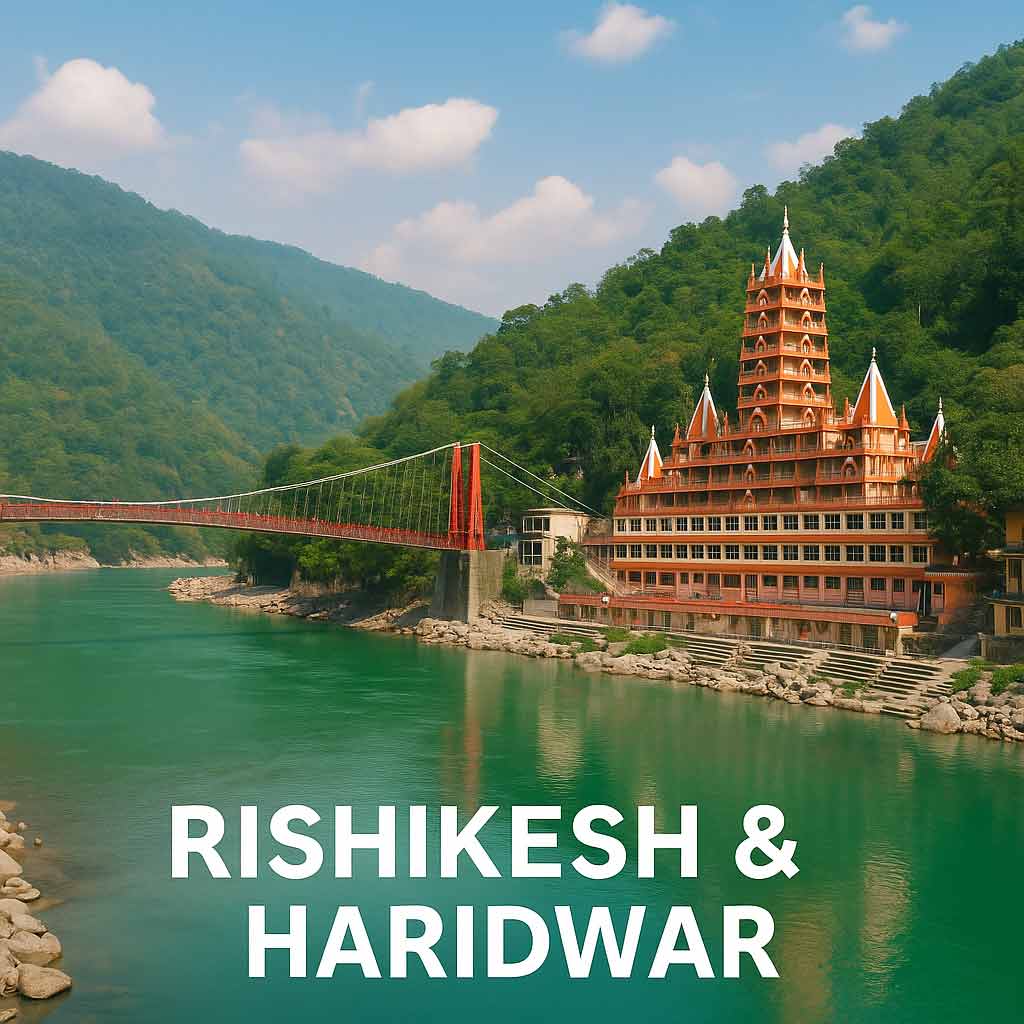
Rishikesh & Haridwar – Uttarakhand – The Twin Spiritual Gateways to the Himalayas Rishikesh and Haridwar – The Twin Spiritual Gateways to the Himalayas Nestled along the sacred banks of the River Ganga in the foothills of the Himalayas, the twin towns of Rishikesh and Haridwar in Uttarakhand are among India’s most revered spiritual destinations. These ancient cities, only about 20 kilometers apart, are gateways to the Char Dham Yatra (Badrinath, Kedarnath, Gangotri, and Yamunotri) and hold a timeless allure for devotees, seekers, and travelers from around the world. Together, they form a seamless blend of divinity, culture, adventure, and natural beauty — where spirituality meets serenity. Haridwar – The Gateway to the Gods The name Haridwar literally means “Gateway to God” (Hari meaning God and Dwar meaning gate). It is one of the seven holiest places in Hinduism and a major pilgrimage site where millions of devotees gather to take a dip in the sacred Ganges River, believed to cleanse sins and lead to salvation. The spiritual heart of Haridwar beats at Har Ki Pauri, a revered ghat where Lord Vishnu is said to have left his footprint. As dusk falls, the Ganga Aarti transforms the atmosphere into a divine spectacle — hundreds of lamps floating on the river, the rhythmic chants of priests, and the fragrance of incense fill the air with transcendence. Witnessing this ceremony is an unforgettable experience that embodies India’s spiritual essence. Haridwar is also home to ancient temples like Mansa Devi, Chandi Devi, and Daksha Mahadev Temple, each carrying mythological significance. The city’s narrow lanes are lined with ashrams, vegetarian eateries, and shops selling Rudraksha beads, copper vessels, and spiritual books. Every twelve years, Haridwar hosts the Kumbh Mela, one of the world’s largest religious gatherings, drawing millions of pilgrims and sadhus. Yet, Haridwar is not only about ritual—it is about rhythm and faith. The calm flow of the Ganga, the ringing temple bells, and the sight of saffron-clad saints together create an atmosphere of deep devotion and simplicity that touches every visitor’s soul. Rishikesh – The Yoga Capital of the World If Haridwar is about faith, Rishikesh is about inner awakening. Known globally as the “Yoga Capital of the World”, Rishikesh has long been a center for meditation, yoga, and spiritual learning. The Beatles’ visit to the Maharishi Mahesh Yogi Ashram in 1968 brought it international fame, and since then, it has become a hub for seekers from across the globe. Located along the same sacred river, Rishikesh is surrounded by lush forests, tranquil ashrams, and the magnificent Himalayan foothills. The Laxman Jhula and Ram Jhula, two iconic suspension bridges spanning the Ganga, are landmarks that offer panoramic views of temples, ghats, and the vibrant life along the riverbanks. On both sides of the river, ashrams such as Parmarth Niketan, Sivananda Ashram, and Omkarananda Ganga Sadan conduct yoga and meditation sessions that attract thousands of learners year-round. Every evening, the Ganga Aarti at Parmarth Niketan mirrors the divinity of Haridwar’s ritual but with a serene, reflective tone, often attended by hundreds of visitors from across the world. The aarti’s chants, performed by young students and saints, create an atmosphere of spiritual unity that transcends languages and religions. Adventure and Nature in the Spiritual Realm Beyond its spiritual essence, Rishikesh is also a haven for adventure enthusiasts. The fast-flowing Ganges offers white-water rafting, one of the most popular activities here. Travelers can also enjoy bungee jumping, ziplining, cliff jumping, and trekking in the nearby Himalayan trails. The Neer Garh Waterfall, Rajaji National Park, and Kunjapuri Temple Trek offer beautiful experiences for nature lovers seeking peace and adventure in equal measure. For many, Rishikesh represents a journey inward — a place to disconnect from the material world and reconnect with the soul. Whether it’s attending the International Yoga Festival, practicing mindfulness by the river, or simply watching the sunrise over the mountains, Rishikesh rejuvenates both body and spirit. A Journey of the Soul Together, Haridwar and Rishikesh form a spiritual circuit that captures the very essence of India — its faith, philosophy, and harmony with nature. Haridwar invites pilgrims to surrender their devotion to the divine, while Rishikesh encourages seekers to find divinity within themselves. The sacred Ganga flows through both towns — as a river, as a mother, and as a symbol of life’s eternal journey. Whether you come to pray, to learn yoga, to find peace, or simply to breathe the Himalayan air, Rishikesh and Haridwar promise an experience that transcends travel — it transforms you.
